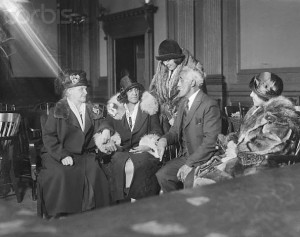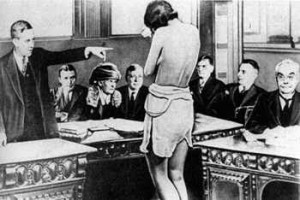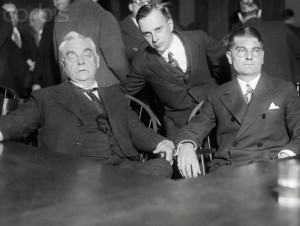
HAPPY HUMP DAY, PRAG OBOTS!
We continue our series on Passing…
ALICE BEATRICE JONES
Love and Race Caught in the Public Eye
From: University of Michigan | By: Heidi Ardizzone, Earl Lewis
Lovers seek to create a place that they can inhabit together against the obstacles of the world. Marriage promises that they will live in that place forever. What happens, though, when love cannot keep out the world’s strictures? What happens when the bond severs, and the nation serves as a witness to marital separation? And what happens when a culture’s notions about love and romance come into conflict with the lines dividing races and classes?
In 1925 Alice Beatrice Jones and Leonard “Kip” Rhinelander found themselves painfully trapped in this conflict between love and family, desire and social standing. Their marriage had the trappings of a fairy tale — wealthy New York scion marries humble girl from New Rochelle — yet the events that led to their estrangement provide an unusual window into the nation’s attitudes about race, class and sexuality. Their sensational annulment trial scandalized 1920s America and opened their private life to public scrutiny, amid cultural conflicts over racial definitions, class propriety, proper courtship and sexual behavior, and racial mixing.
As a Rhinelander, Leonard was descended from several of New York’s oldest and wealthiest families. Had he followed in the family tradition, Leonard might have attended Columbia University, joined the Rhinelander Real Estate Company, and made his mark on New York society through philanthropy and support of the arts.
By contrast, Alice’s parents immigrated in 1891 to the United States from England, where they had both worked as servants. George Jones had had some success in his adopted country; he eventually owned a fleet of taxicabs and several small properties. Alice, her sisters, and their husbands worked primarily as domestics and servants — solid members of the working class.
Despite this pronounced class difference, Alice and Leonard met and began dating in 1921. Their love deepened over the next three years, tested by months and years of separation as Leonard’s father tried to keep them apart. Philip Rhinelander’s efforts were in vain, however. From 1921 to 1924 the lovers exchanged hundreds of letters and visited when possible. As soon as Leonard turned 21 and received money from a trust fund, he left school and returned to Alice. In the fall of 1924, they quietly married in a civil ceremony at the New Rochelle City Hall.
Had reporters from the New Rochelle Standard Star ignored the entry in the City Hall records, the couple might have lived their lives away from the public spotlight. They did not. Someone eventually realized that a Rhinelander had married a local woman, and it was news. And once they discovered who Alice Jones was, it was big news. The first story appeared one month after their wedding, announcing to the world that the son of a Rhinelander had married the daughter of a colored man.

Or had he? Well, at least he had married the daughter of a working-class man, and that was enough to start a tremor of gossip throughout New York. Reporters rushed to sift through the legal documents and contradictory accounts of and by the Joneses and the newlyweds. Despite the confidence of the first announcement, there was confusion for quite some time as to George Jones’s — and therefore Alice’s — precise racial identity.
Leonard initially stood by his wife during the tumult of national coverage of their cross-class, possibly cross-racial, marriage. But after two weeks, he left her and signed an annulment complaint that his father’s lawyers had prepared. The suit charged Alice with misrepresenting her racial identity to her would-be husband. She was black, the document asserted, but had tried to pass as white. She was not the woman Leonard thought she was when he married her.
Our interest in the Rhinelander case began more than 18 years ago, when Earl came across newspaper accounts of the trial in the Norfolk Journal and Guide. The story pulsed with the complexities of race and identity in Jim Crow-era America, and he couldn’t pull himself away from it. A dozen years later he mentioned the story to Heidi, who began tracking down more information but eventually decided not to incorporate it into her dissertation. Instead, we decided to try a collaborative effort, and Heidi began a series of trips to Westchester County and New York City, tracking trial records, legal documents, and New York newspaper coverage and looking for surviving members of the families involved. We produced an article and quickly turned to writing a book.

Every researcher knows that of the many paths of inquiry planned, some will inevitably lead nowhere. We were, nonetheless, quite surprised to find that, despite repeated inquiries, our research failed to produce an extant copy of the court transcript in the Westchester County courthouses or their archives, or in the appellate courts, newspaper archives or lawyers’ offices. Tantalizing hints of its existence materialized, including an index of testimony and documents from subsequent legal challenges. Unfortunately, none of the courts could produce the transcript.
Without a transcript, we turned to newspaper coverage of the case. We culled pertinent coverage from several dozen national newspapers — black- and white-published — including dailies and tabloids from New York City and neighboring communities. From these sources we re-created the trial, sometimes overlaying numerous accounts of the same event to reconcile discrepancies or omissions. Our ability to do so was aided immensely by several daily newspapers’ habit of reproducing each day’s court record alongside their summaries, editorials, photographs, and cartoon coverage.
The regional and racial diversity of the sources gave us a more highly textured story than we first imagined, one that enabled us to gauge how the nation responded to its unfolding. Depending on newspapers made us aware not only of the immense popularity of the case but also of how the story reached different audiences with different messages and, to some extent, how the readership responded. Our book became a study of the cultural response to the trial and the issues it raised as much as it was an analysis of the trial itself.
Another path we hoped to pursue lay in finding Alice or Leonard or family members who might have more information about their relationship and lives after the trial. We quickly learned that Leonard had died in 1936, but we had no idea if Alice had remarried, had had children, or still lived. The New York Times had no obituary for her, nor did the New Rochelle Standard Star. While Alice was listed in city directories until the 1960s, apparently still living in her childhood home, thereafter she either moved or maintained an unlisted address. Local people remembered the case, but no one knew where she was.
One day in New Rochelle, after pursuing several unfruitful leads, Heidi stopped by the local cemetery, where she knew Alice’s parents were buried. The office had no record of Alice being buried with her family, but Heidi decided to visit the family plot anyway. As she walked around reading the graves, she literally tripped over a small flat stone lying almost flush with the grass. There was Alice’s grave. She had died in 1989.

More so than the absence of a transcript, the inability to interview participants and observers of the events left several still-unanswered questions. (Though more distant Rhinelanders did reply to our inquiries, most family members could not be found or declined to respond.) Most importantly, how did George and Alice define themselves racially? At the beginning of the trial, Alice’s lawyers said that Alice “had some colored blood in her veins.” Although the lawyers said they had only made the admission “for the purposes of the trial” and were careful never to call her black, most Americans understood that having colored ancestry meant she was black, albeit of mixed ancestry.
Her sisters both acknowledged on the witness stand that they were colored, and that they had never denied it. Their mother, Elizabeth, who was white, made a sharp distinction between having colored blood and being black. She was surprised that her husband was considered a Negro in the United States. She believed he was a mulatto but not black. This distinction, of course, contradicted white America’s system of popular and legal racial classification, which held that just one drop of black blood made one black. As a rule, Americans made few distinctions between colored and Negro by the 1920’s; gradations in mixed blood had given way to absolutes.
The illogic of such definitions did not go unnoticed by many blacks and some whites. Still, George Jones’s skin was dark enough that all who saw him agreed that in the American racial lexicon he could not be called white. He claimed only to know that his mother was white and his father had been a subject of the British colonies. But his daughters’ appearances were more ambiguous. Interviews with family members, neighbors, and friends did not clarify matters much. They offered conflicting stories of what people thought they were, how they presented themselves, and whether they defined themselves as black, white, colored or something else entirely.
Whether or not George and Elizabeth thought he was black, the family was clearly considered mixed by most people in their community, and their union threatened settled assumptions in Jim Crow-era America. By the 1920s, prohibitions against interracial marriage existed in more than half of the states. Most of these statutes also tried to define who was black and who was white — most using the one-drop rule, some offering a specific blood quantum (such as anyone with at least one-eighth black ancestry was black).
Although the US Supreme Court had refused in Plessy v. Ferguson to provide a definition of black and white, it did offer an opinion in 1924 on whether Asian Indians were white. The case in question involved an Indian immigrant, Bhagat Thind, who argued that he was Caucasian and therefore white and therefore eligible for US citizenship, from which Asian immigrants were excluded. The court agreed with him on one count: He was Caucasian. The majority concluded he was not white, however, since the perceptions and beliefs of the average man defined whiteness by pale skin and European ancestry. The Thind case made clear that American legal racial categories were socially constructed, not based in scientific racialism. It also highlighted the racial fissure many immigrants like George Jones experienced as they found themselves placed in a different classification in the United States than they had previously occupied.
(CLICK BELOW TO CONTINUE TO PAGE 2)

